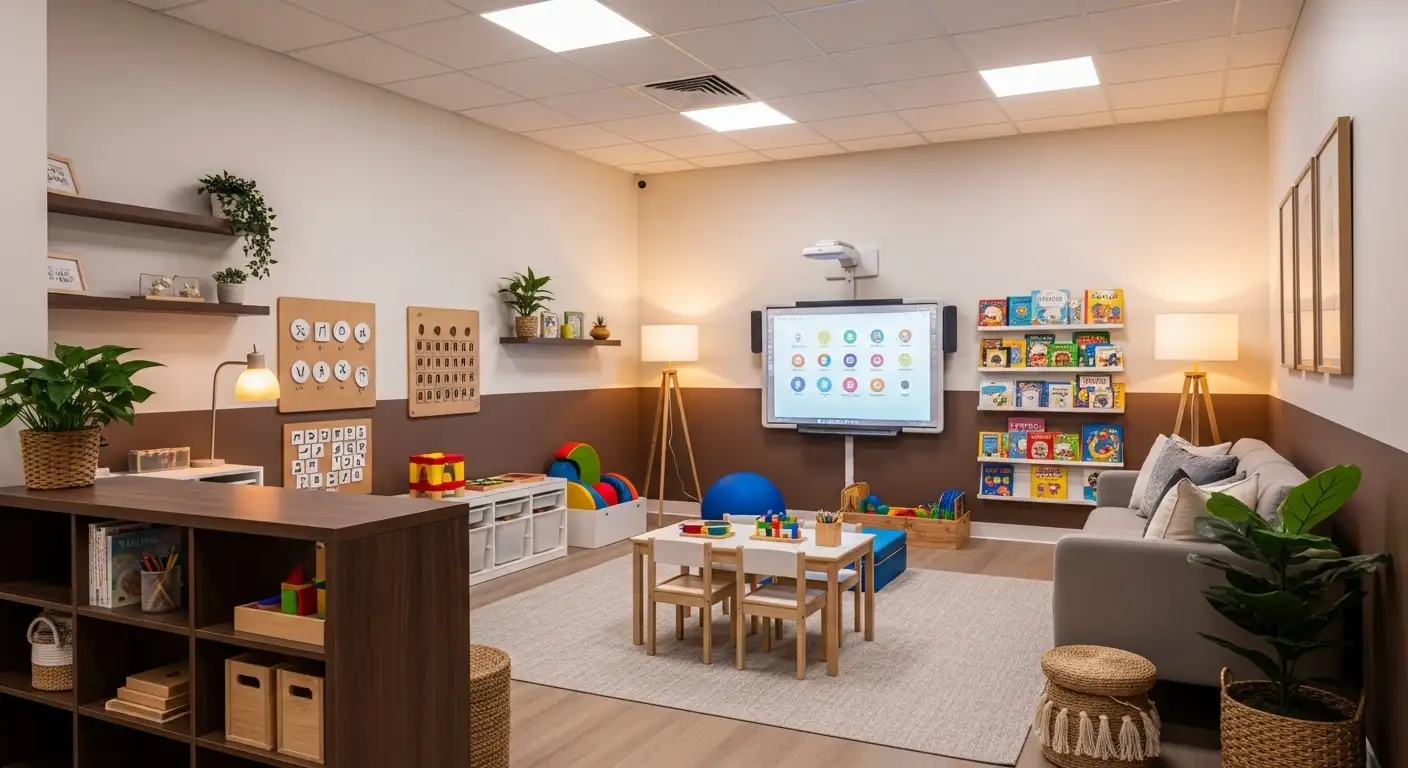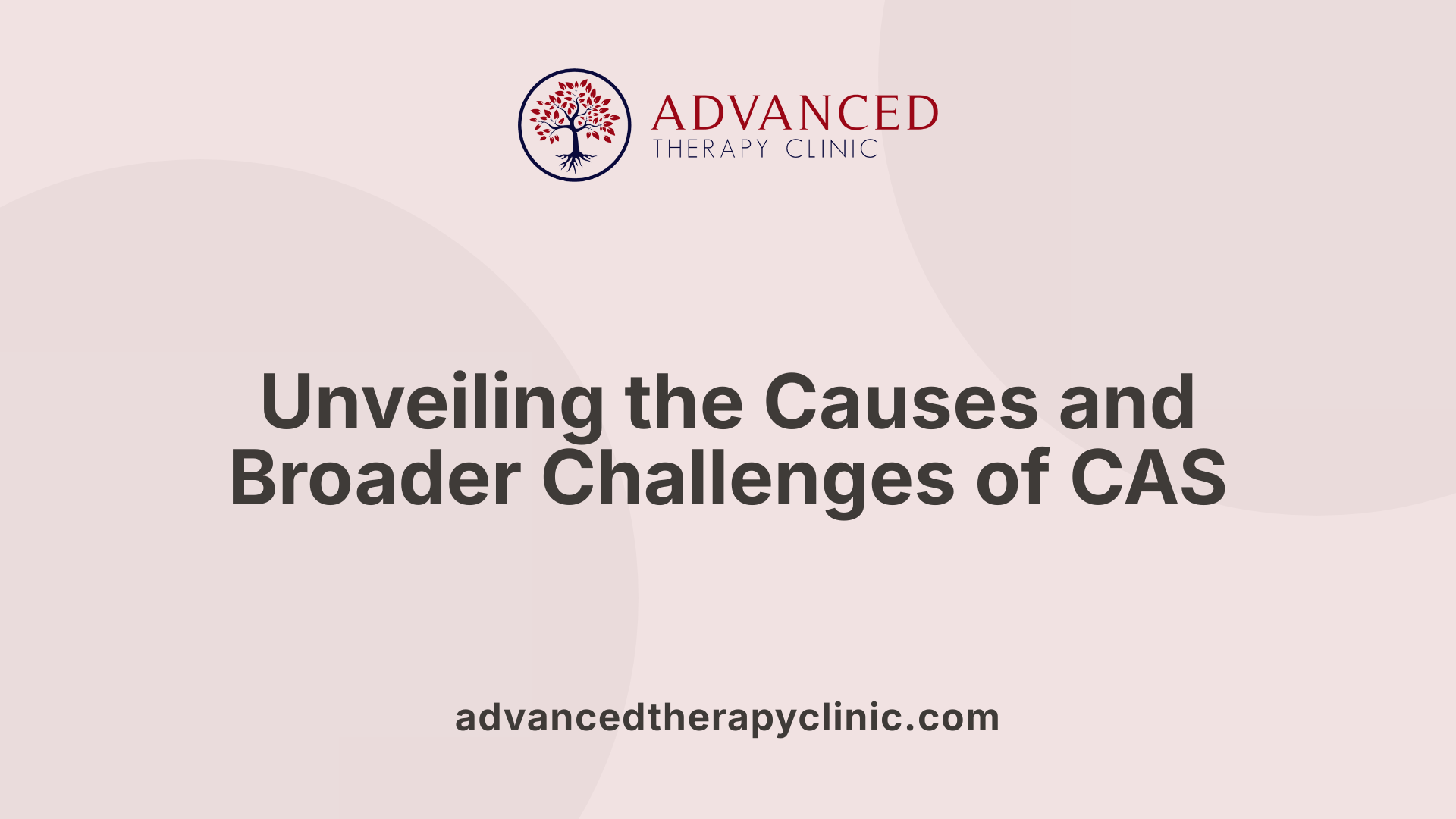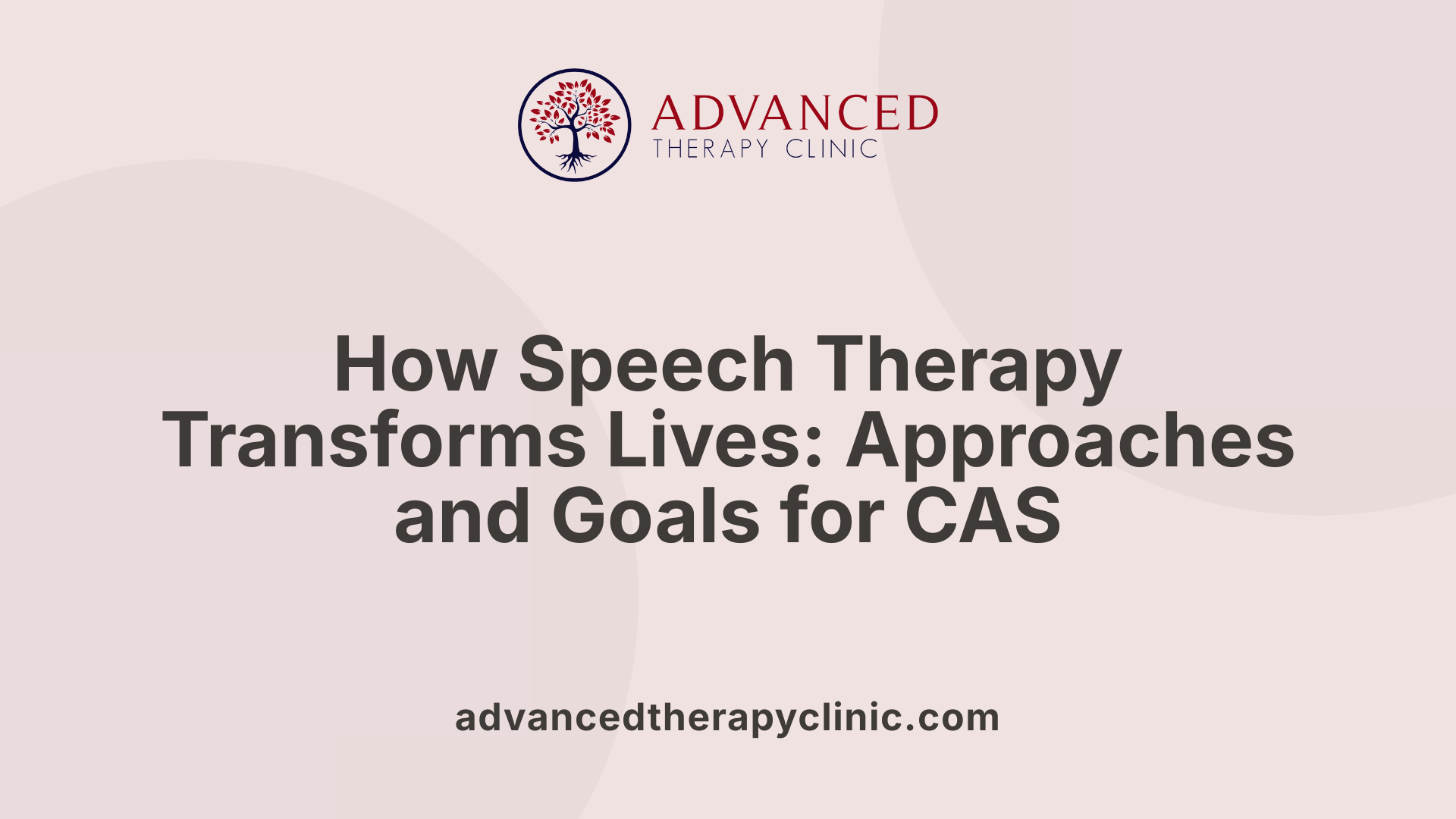The Role of Speech Therapy in Treating Childhood Apraxia of Speech


Understanding Childhood Apraxia of Speech and Its Challenges
Childhood Apraxia of Speech (CAS) is a complex motor speech disorder that disrupts a child's ability to coordinate the movements needed for clear and accurate speech. Despite adequate muscle strength, children with CAS struggle to produce consistent and intelligible speech, making early identification and specialized treatment essential. Speech therapy plays a central role in managing CAS, helping children improve their communication skills and participate more fully in everyday life.
What is Childhood Apraxia of Speech (CAS)?

What is Childhood Apraxia of Speech?
Childhood Apraxia of Speech (CAS) is a motor speech disorder characterized by the brain's inability to properly coordinate messages to the muscles involved in speaking. Despite normal muscle strength, children with CAS struggle to plan and sequence the movements needed for clear speech.
Nature of the Disorder
CAS affects the precision and consistency of speech movements, making it difficult for affected children to produce accurate sounds, syllables, and words. This difficulty arises from the impaired planning and programming of speech motor movements rather than muscle weakness.
Other Names for CAS
CAS is also known as verbal dyspraxia or developmental apraxia. These terms reflect the disorder's impact on speech motor planning and coordination.
Symptoms Commonly Observed in Children with CAS
Children with CAS often exhibit inconsistent production of speech sounds, incorrect stress patterns on syllables or words, and frequent distortions of sounds. They may also find it easier to produce shorter, simpler words than longer, more complex ones. These speech challenges can significantly affect a child's communication abilities.
This summary captures the foundational understanding of CAS, highlighting its cause, alternate names, and main characteristics observed in young children.
Causes and Associated Challenges of CAS

What causes CAS and what associated problems can children face?
Childhood Apraxia of Speech (CAS) can stem from various causes, though often the exact origin remains unknown. Some cases are linked to brain damage due to genetic disorders or syndromes, while others may arise after events such as stroke or traumatic brain injury. These neurological issues interfere with the brain's ability to send correct messages to the muscles involved in speech.
Beyond speech difficulties, children with CAS frequently face additional developmental challenges. Problems with fine motor skills are common, affecting their ability to coordinate small muscle movements needed for tasks other than speaking. Language delays are also prevalent, meaning these children may take longer to develop listening, understanding, and speaking abilities compared to peers.
Moreover, CAS can impact literacy skills. Many children experience difficulties with reading, spelling, and writing, possibly due to the intertwined nature of language and cognitive-motor functions. These associated challenges highlight the importance of comprehensive support that extends beyond speech therapy, often involving occupational or educational interventions.
Understanding these causes and their broader effects clarifies why early diagnosis and targeted therapy are crucial. Prompt and intensive treatment can help address not only speech motor planning issues but also associated developmental needs, promoting better overall communication and learning outcomes for affected children.
Diagnosis and Assessment of CAS

Diagnostic process
Childhood apraxia of speech (CAS) diagnosis is carried out by speech-language pathologists (SLPs) through a combination of reviewing symptoms, medical histories, and detailed speech and oral-motor evaluations. This comprehensive approach ensures an accurate understanding of the child’s speech difficulties and excludes other possible conditions.
Assessment components
Assessment often includes hearing tests to rule out auditory issues that may affect speech. SLPs evaluate oral-motor skills — how the lips, tongue, and jaw move during speech — alongside speech melody, rhythm, and overall intelligibility. This multi-faceted testing helps capture the child’s coordination and execution of speech movements.
Challenges in diagnosing CAS
Diagnosing CAS can be difficult because it relies on observing patterns of inconsistent speech errors, unusual stress patterns on syllables, and speech sound distortions rather than a single definitive test. The challenge increases with children who have very limited speech or difficulties interacting, as fewer examples are available for evaluation. Early identification is crucial since CAS requires tailored therapies different from other speech disorders, but initial diagnosis may sometimes remain uncertain due to these complexities.
Role of Speech Therapy in CAS Treatment

What role does speech therapy play in treating CAS?
Speech therapy is the cornerstone of treatment for Childhood Apraxia of Speech (CAS). It focuses on improving speech clarity by helping children learn how to plan and sequence the movements their mouths must make for accurate speech. Speech-language pathologists (SLPs) design individualized therapy sessions that target the motor planning deficits intrinsic to CAS.
Primary treatment approach
Therapy typically occurs 3-5 times per week, with sessions lasting between 30 and 60 minutes. These intensive and frequent sessions are critical since children with CAS require more practice to achieve functional speech goals. Early intervention with high-intensity therapy supports better motor learning and speech production.
Goals of therapy
The main therapy objectives include:
- Teaching correct movements of the lips, tongue, jaw, and palate
- Practicing speech motor sequences from single sounds to syllables, words, and phrases
- Enhancing speech clarity and naturalness
- Building confidence through quick successes
- Encouraging communication using meaningful, functional words
Speech motor planning and programming
Treatment targets the child's ability to plan and execute speech movement sequences. Children repeat syllables, words, and phrases many times in each session to improve accuracy and consistency. The emphasis is on motor control—not just muscle strength—since CAS reflects planning and programming difficulties.
Use of sensory cues and feedback
Therapists incorporate various sensory cues to guide speech:
- Visual (e.g., watching mouth movements)
- Tactile (e.g., touch cues on the face or jaw)
- Verbal prompts
These cues act as reminders to help children execute precise speech movements. Over time, cues are gradually faded to foster the child's independence. Feedback includes specific correction tips and positive reinforcement, carefully timed to optimize learning.
The integration of these targeted techniques makes speech therapy essential in helping children with CAS improve their speech production and communicative abilities.
Effective Therapy Approaches and Programs for CAS

Which therapeutic approaches are proven effective for treating CAS?
Several therapy programs have been shown to be effective for treating Childhood Apraxia of Speech (CAS), tailored to different age groups and severity levels.
Dynamic Temporal and Tactile Cueing (DTTC): This approach has moderately strong evidence supporting its effectiveness. It is designed for children aged two years and above, particularly those with moderate to severe CAS. DTTC uses systematic cueing strategies to help children plan and execute speech movements.
Rapid Syllable Transition Training (ReST): ReST has very strong research backing, specifically for children aged 4 to 12 years with mild to moderate CAS and ataxic dysarthria. It focuses on practicing syllable transitions to improve speech fluidity.
Integrated Phonological Awareness Training (IPA): IPA provides moderately strong evidence for treating speech-language impairments including CAS in children aged 4 to 7 years. It integrates speech therapy with phonological awareness activities.
Nuffield Dyspraxia Program, Third Edition (NDP3): NDP3 has very strong support for addressing severe speech sound disorders including CAS in children aged 3 to 7 years. It can also be adapted for other age groups and offers structured, progressive therapy.
Other treatment methods like PROMPT, the Kaufman Speech to Language Protocol (K-SLP), and Speech-EZ are used for communication and speech sound issues but currently lack extensive research specific to CAS effectiveness.
Each of these programs incorporates intensive practice, sensory cueing, and repetition to help children develop accurate speech motor planning and improve intelligibility.
Importance of Therapy Intensity and Practice Frequency

What is the recommended therapy frequency and duration for CAS?
For children with Childhood Apraxia of Speech (CAS), consistent and frequent therapy sessions are essential. The American Speech-Language-Hearing Association (ASHA) recommends that children receive intensive therapy, typically 3 to 5 sessions per week. Each session generally lasts between 30 and 60 minutes, allowing targeted practice on speech motor planning and programming.
How does treatment intensity impact outcomes for children with CAS?
Research strongly supports that higher treatment intensity results in significantly better outcomes in speech production, clarity, and overall communication skills. Intensive therapy harnesses motor learning principles by providing ample repetition, which is crucial for children to improve the coordination of speech movements. The frequent practice reinforces speech sequences, prosody, and motor control, helping the child gain greater independence in speaking.
How many therapy sessions are typically required for effective CAS treatment?
Children with CAS often require many more therapy sessions compared to those with other speech disorders. Studies indicate that more than 150 sessions may be necessary to reach functional speech goals. Early on, shorter but more frequent sessions are beneficial, especially for severe cases, focusing on motor skill acquisition and building confidence through quick successes.
Maintaining a high frequency of therapy combined with focused, repetitive practice offers the best chances for children with CAS to improve their speech abilities and communication effectiveness. The commitment to intensive therapy reflects the complex nature of CAS and the need for dedicated motor planning interventions.
Therapy Techniques: Practice, Cueing, and Feedback

How Are Practice and Motor Learning Principles Applied in CAS Therapy?
Speech therapy for children with Childhood Apraxia of Speech (CAS) heavily relies on repetition and motor learning principles. Children are guided to practice syllables, words, and phrases multiple times within each session. This constant repetition helps the brain strengthen the pathways needed for planning and executing speech movements, improving accuracy over time.
What Role Do Cueing Strategies Play in Therapy?
Therapy incorporates various cueing methods to support speech production. Visual cues might include watching a therapist’s mouth movements, while tactile cueing involves touch prompts on the face or throat to remind where to place articulators. Verbal cues guide the sounds to be produced. These prompts are carefully designed to be gradually faded as the child gains independence in speech.
How Is Feedback Utilized During Speech Sessions?
Feedback in CAS therapy comprises two types: knowledge of performance and knowledge of results. Knowledge of performance delivers specific, corrective tips on how to improve speech movement during attempts. Knowledge of results focuses more on recognizing success or near success, reinforcing motivation. Therapists manage the timing and quantity of feedback to encourage learning without overwhelming the child.
How Do Rhythm and Prosody Techniques Help?
Using rhythm and prosody techniques, such as clapping or tapping, therapists help children develop natural speech pacing and intonation. These techniques emphasize stress and timing in speech, making it easier for the child to produce fluid and expressive language patterns.
| Technique | Description | Purpose |
|---|---|---|
| Repetition & Motor Learning | Multiple attempts at speech units per session | Enhances neural pathways for speech |
| Visual, Tactile, Verbal Cueing | Sensory prompts to guide articulator placement and speech movements | Supports accurate production and independence |
| Feedback (Performance & Results) | Specific corrections and encouragement based on speech attempts | Facilitates learning and motivation |
| Rhythm & Prosody | Clapping/tapping to emphasize speech stress and timing | Improves speech naturalness and pacing |
Integrating Functional Communication and Real-Life Practice

How does therapy support functional communication in children with CAS?
Therapy for children with childhood apraxia of speech (CAS) emphasizes using functional words early in treatment rather than waiting for perfect articulation of individual sounds. This approach helps children practice and use speech in meaningful, everyday situations, improving their motivation and engagement.
Balancing accuracy with functional use is crucial. Therapists focus on quick successes to build confidence and reduce frustration, ensuring children experience positive outcomes during therapy sessions. This balance aids in maintaining motivation while working toward clearer speech.
Family involvement is a cornerstone of effective therapy. Speech-language pathologists guide parents and caregivers in practicing speech exercises at home and in real-life situations to reinforce gains made during sessions. Consistent home practice accelerates progress and supports the generalization of speech skills.
Augmentative and alternative communication (AAC) methods such as sign language, gestures, or communication devices play a supportive role, especially when speech is severely impacted. AAC provides children with additional tools to express themselves while developing their verbal skills, enhancing overall communication and reducing frustration.
Multidisciplinary Support: Beyond Speech Therapy

Common coexisting issues with CAS
Children with Childhood Apraxia of Speech (CAS) frequently experience challenges beyond speech difficulties. Many also face language delays and motor skill impairments, particularly involving fine motor coordination. These additional hurdles can affect their overall communication, learning, and daily activities, making a broader therapeutic approach essential.
Role of other therapies (occupational, physical)
To address these coexisting challenges, children with CAS may benefit from occupational therapy (OT) and physical therapy (PT). Occupational therapy focuses on improving fine motor skills, hand-eye coordination, and self-care abilities, which can influence speech-related movements and general motor control. Physical therapy targets gross motor skills, balance, and muscle tone, helping children develop better overall movement and posture, which indirectly supports speech production.
Therapists specializing in OT and PT work alongside speech-language pathologists to ensure that therapy goals align and progress in one area supports gains in others.
Importance of coordinated care
Coordinated care among speech-language pathologists, occupational therapists, physical therapists, and families is vital. This teamwork enables a comprehensive treatment plan tailored to the child's unique needs. Regular communication and shared strategies ensure consistency and prevent conflicting interventions.
Such multidisciplinary collaboration maximizes the child’s developmental progress and improves quality of life. It also assists families in managing multiple therapies, guiding home practice, and advocating effectively for their child's needs.
| Therapy Type | Focus Area | Contribution to CAS Management |
|---|---|---|
| Speech Therapy | Speech motor planning and production | Direct improvement in speech clarity and intelligibility |
| Occupational Therapy (OT) | Fine motor skills, coordination | Supports oral motor control and daily functional skills |
| Physical Therapy (PT) | Gross motor skills, posture | Enhances overall motor function indirectly aiding speech |
| Coordinated Multidisciplinary Care | Integrated goal setting | Ensures holistic approach and consistent therapy reinforcement |
Challenges in CAS Treatment and What Is Not Effective

Limitations and challenges in therapy
Treating Childhood Apraxia of Speech (CAS) is inherently challenging due to its nature as a motor speech planning disorder rather than one caused by muscle weakness. Therapy demands intense and frequent practice focusing on the motor planning and sequencing of speech movements. Children often require numerous sessions—often exceeding 150—to achieve significant improvements, making treatment a long-term commitment.
Additionally, children with CAS frequently exhibit coexisting issues such as language delays and motor difficulties, complicating therapy and sometimes necessitating additional types of intervention like occupational or physical therapy. Therapy sessions typically need to occur multiple times per week, emphasizing repetition and motor learning, which can be demanding for both the child and family.
Ineffective treatment approaches
It is important to recognize that not all treatment methods are beneficial for CAS. Specifically, there is no evidence supporting the effectiveness of exercises aimed at strengthening the speech muscles. CAS does not stem from muscle weakness, but from impaired motor planning and programming. Thus, therapies focusing solely on muscle strength do not address the root cause and are unlikely to yield meaningful improvement.
Successful treatments are those that incorporate speech motor planning practice, use sensory cueing (visual, verbal, tactile), and emphasize practice of speech sequencing through repetition. Treatments ignoring these principles typically fail to produce progress.
Managing expectations
Because CAS requires intensive, targeted therapy and often involves a prolonged timeline, it is crucial for families and caregivers to have realistic expectations. Improvement is typically gradual, and early success is encouraged to build confidence and reduce frustration. Family involvement in home practice, guided by speech-language pathologists, is essential to reinforce therapy gains.
Understanding that immediate or rapid changes are uncommon can help manage disappointment and sustain motivation. Even with best practices, sentence-level intelligibility might improve more slowly than single words or syllables, highlighting the importance of ongoing commitment to therapy.
The Critical Role of Early Identification and Family Support

Why is early identification and family support important in CAS treatment?
Early identification of Childhood Apraxia of Speech (CAS) is essential because it allows speech-language pathologists to begin specialized therapy tailored to the unique needs of children with this motor speech disorder. CAS differs significantly from other speech impairments, so recognizing it promptly means therapy can target the specific challenges of speech motor planning and programming early on.
Research shows that early intervention in CAS dramatically improves speech clarity and communication outcomes. When therapy starts at a young age, children have more opportunities to develop the complex sequencing needed for accurate speech, reducing long-term communication barriers.
Family involvement is a cornerstone of successful CAS therapy. Parents and caregivers who actively participate by practicing speech exercises at home help reinforce the skills learned in therapy sessions. Collaboration with speech-language pathologists ensures that families understand techniques and strategies suited for their child’s needs.
Moreover, a supportive home environment that encourages communication, patience, and positivity boosts the child’s confidence. This encourages more frequent and motivated practice, which is vital given that CAS therapy demands consistent repetition and intensive practice to improve speech motor function.
In summary, early diagnosis combined with engaged family support creates a powerful foundation for effective intervention, leading to better speech development and functional communication for children with CAS.
Moving Forward: Empowering Children with CAS Through Speech Therapy
Speech therapy remains the cornerstone for treating Childhood Apraxia of Speech, targeting the intricate motor planning difficulties that define this disorder. Evidence-based, intensive, and individualized therapy approaches, combined with ongoing family involvement and multidisciplinary support, offer children with CAS the best opportunity to develop functional, intelligible speech. Early diagnosis and treatment initiation are crucial to maximize progress and improve communication outcomes, helping affected children unlock their full potential and engage confidently with the world around them.
References
Recent articles

Expressive Speech Delay 2-Year-Old
Understanding and Addressing Expressive Speech Delay in Toddlers

How Speech Recognition Works
Unlocking the Power of Speech Recognition in Therapy and Healthcare

Autism and Head Size
Understanding the Complex Relationship Between Autism and Head Size

Occupational Therapy in Autism
Enhancing Independence and Quality of Life Through Occupational Therapy in Autism

Do Autistic People Understand Sarcasm?
Navigating the Nuances: Understanding Sarcasm and Social Communication in Autism

Autism Routines
Crafting Effective Daily Structures for Children with Autism


